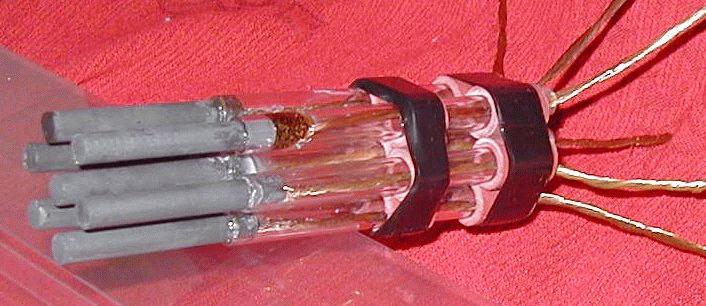Organikum
resurrected
    
Posts: 2337
Registered: 12-10-2002
Location: Europe
Member Is Offline
Mood: frustrated
|
|
electrolytic chlorinations
electrodearray:

This is made from graphite rods from batteries and some glasstubing/rubbertubing and works astonishing well.
The central electrrode is the cathode where hydrogen is evolved, the outer rods serve as anodes providing a higher surface area where the substrate
gets chlorinated.
Powered is the array by an old AT-PS on the 5V line.
Some pictures "in action" will follow.
|
|
|
Polverone
Now celebrating 21 years of madness
        
Posts: 3186
Registered: 19-5-2002
Location: The Sunny Pacific Northwest
Member Is Offline
Mood: Waiting for spring
|
|
That is a thing of beauty. Can it electrolytically chlorinate acetic acid? If it can, I must build one myself! Chloroacetic acid is such a versatile
starting point for so many compounds, yet requires some real technochemistry to make at home.
PGP Key and corresponding e-mail address
|
|
|
Organikum
resurrected
    
Posts: 2337
Registered: 12-10-2002
Location: Europe
Member Is Offline
Mood: frustrated
|
|
No.
Acetic acid is not to chlorinate electrolytically (sure) and also not by chlorine directly (as far as I remember).
It is for this property widely used as solvent in electrolytic chlorinations.
no way. sorry.
The electrode array is by no way final but a quick to disassemble/reassemble experimental prototype. I actually used three different ways to fix the
carbon rods, PVC-melt in, epoxide and waterglass to see what stands best.
|
|
|
Theoretic
National Hazard
   
Posts: 776
Registered: 17-6-2003
Location: London, the Land of Sun, Summer and Snow
Member Is Offline
Mood: eating the souls of dust mites
|
|
"Acetic acid is not to chlorinate electrolytically (sure) and also not by chlorine directly (as far as I remember)."
Actually, chloroacetic acid is obtained by catalytic chlorination fo acetic acid (the catalyst being P or S). The catalyst is used to speed up the
process. Sunlight is also highly recommended, as it speeds up chlorinations. Acetic acid is susceptible to chlorinations, as the carboxyl group
activates the molecule. This explanation is given by a chemistry book to explain why carboxylic acids are chlorinated directly (and a diagram of the
reaction).
On the array: nice DIY mad science! I bet it's perfect for preparation of NaClO3 (at temperatures not too high to prevent erosion). A universal
piece of apparatus!
|
|
|
MnkyBoy
Harmless

Posts: 8
Registered: 30-3-2003
Member Is Offline
Mood: constipated
|
|
Very nice unit Orgy...For some reason it doesn't suprise me though...But again good work (as usual)
|
|
|
solo
International Hazard
    
Posts: 3975
Registered: 9-12-2002
Location: Estados Unidos de La Republica Mexicana
Member Is Offline
Mood: ....getting old and drowning in a sea of knowledge
|
|
RE: chlorination
Organikum......nice work , what is the source or chlorine for the apparatus, second will it
chlorinate a primary aromatic alcohol?
What are the current requirements i.e. time , voltage, how will you test if the chlorination is done ? TLC?
This is much better than thionyl chloride, if you can get it, and those pesty Phosphorous Halides.
Again congratulations on this design and avant guard approach to al old problem......solo
It's better to die on your feet, than live on your knees....Emiliano Zapata.
|
|
|
Organikum
resurrected
    
Posts: 2337
Registered: 12-10-2002
Location: Europe
Member Is Offline
Mood: frustrated
|
|
The chlorine source is the HCl which is electrolytically splitted into Hydrogen and chlorine.
This method as described is not useful for the chlorination of alcohols on the hydroxy group(s). It is even not useful for sidechainchlorinations,
toluene or similar.
Alcohols require H-X (X being a halogen)and in the case of HCl some help from sulfur, phosphor or zincchloride. Alternativly very rough conditions do
the trick - high temperatures and pressure.
In case the halogenation is to be done for later reduction by catalytic hydrogenation I would plead for bromine or direct reduction using perchloric
acid or H2SO4 as promotor.
|
|
|